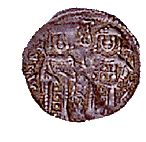 |
|
 |
State funds: loans and confiscations
 he empress
he empress
 Anna of Savoy
provides us with a typical example of the penury of the Byzantine state. At the beginning of the second civil war, Anna pawned the imperial jewels in Venice, in order to secure a loan of 30,000 ducats. Thereafter, the Venetians never failed to remind the Byzantines of their debt whenever an agreement was to be renewed between them. Finally, since the money was never returned, the jewels remained in the treasury of the Church of St. Mark in Venice. The bad financial situation, which even affected the palace, is dramatically revealed by the fact that, at the coronation ceremony of
John VI Kantakouzenos,
cups of lead or clay were used instead of vessels of gold or silver.
Anna of Savoy
provides us with a typical example of the penury of the Byzantine state. At the beginning of the second civil war, Anna pawned the imperial jewels in Venice, in order to secure a loan of 30,000 ducats. Thereafter, the Venetians never failed to remind the Byzantines of their debt whenever an agreement was to be renewed between them. Finally, since the money was never returned, the jewels remained in the treasury of the Church of St. Mark in Venice. The bad financial situation, which even affected the palace, is dramatically revealed by the fact that, at the coronation ceremony of
John VI Kantakouzenos,
cups of lead or clay were used instead of vessels of gold or silver.
Later on, in 1370, in an effort to collect money,
John V Palaiologos
promised the island of Tenedos to the Venetians. The latter, in exchange, would return the crown jewels his mother had pawned 30 years before, along with 6 transport vessels and a sum of 25,000 ducats. John received 4,000 ducats in advance, but the deal fell through, as
Andronikos IV,
who was acting as regent in Constantinople at the time, refused to surrender Tenedos. It is also worth mentioning that, following the victory of the Ottomans at the river Hebros in 1371,
Manuel II
, who was then ruler of Thessalonike, tried to confiscate half the property of the monasteries of Thessalonike and Mount Athos in order to distribute it as pronoia holdings to his soldiers. This measure of his, which was prompted by his desire to strengthen the defences of the state in the case of a Turkish offensive, and which met with the strong opposition of the Church, constitutes yet another indication of the tragic financial situation of the state.
|